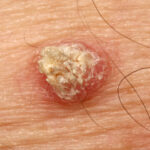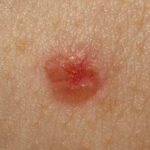Skin Cancer Therapy

There are three common forms of skin cancer: basal cell carcinoma, squamous cell carcinoma, and malignant melanoma. Anyone can be diagnosed with skin cancer at any age.
Doctors link all three of these forms of cancer to overexposure to the sun. Tanning booths can increase your risk, as can exposure to radiation or high altitude. Because each type of skin cancer has a different appearance, it is important to alert your physician if you notice unusual changes in the size and shape of spots. Time is of the essence, and when caught early, most skin cancer can be successfully treated.
Basal Cell Carcinoma
This is the most common type of skin cancer. Like all skin cancers, basal cell carcinomas can develop on any area of the body. However, they most often appear on skin that gets lot of sun, such as the face, scalp, neck, hands, and arms. They can appear as a reddish area of dry skin that won’t heal, a flesh-colored (or pink, red, or brown) pearl-shaped bump, a pimple that just won’t clear over several months, a sore that bleeds, heals, and then returns, or a scar-like area that feels waxy. It frequently will have small blood vessels on the surface. While this form of cancer is rarely life threatening, failure to treat it in a timely manner can cause serious damage to surrounding tissue and bones.
Squamous Cell Carcinoma
 Squamous cell carcinoma is the second most common type of skin cancer and usually occurs on chronically sun exposed areas such as an ear, face, bald scalp, neck, or arm.
Squamous cell carcinoma is the second most common type of skin cancer and usually occurs on chronically sun exposed areas such as an ear, face, bald scalp, neck, or arm.
Too much sun exposure is often the cause, but it is not the only possible cause. Squamous cell carcinoma can develop on areas which never receive sun exposure such as inside the mouth or on the genitals. Squamous cell carcinoma can also develop in old scars. A squamous cell carcinoma often has a reddish color and can feel rough or gritty. They may also appear as non-healing sores. If not treated, they can spread to the internal organs and become a life threatening condition. The thicker they become prior to being diagnosed the more likely they are to spread beyond the local area of skin.
Malignant Melanoma
 Malignant melanoma is the third most common form of skin cancer, and is by far the most dangerous. If not treated quickly, it can spread throughout the entire body, proving fatal.
Malignant melanoma is the third most common form of skin cancer, and is by far the most dangerous. If not treated quickly, it can spread throughout the entire body, proving fatal.
Know where you have moles on your skin. Melanoma often appears in an existing mole or looks like a new mole. By knowing where you have moles on your skin, you can find melanoma when it first appears. When treated early, melanoma is often curable.
Anyone of any age can get melanoma. However, unlike basal cell and squamous cell carcinomas which usually occur in chronically sun damaged skin, melanomas are more common in persons between 20 and 40 years of age.
It’s important to take time to look at the moles on your skin because this is a good way to find melanoma early. When checking your skin, you should look for the ABCDEs of melanoma.
Consult your dermatologist immediately if any of your moles or pigmented spots exhibit:
- A – Assymetry – One half is unlike the other half
- B – Border – An irregular, scalloped or poorly defined border.
- C – Color – Is varied from one area to another; has shades of tan, brown, or black; or is sometimes white, red or blue.
- D – Diameter – Melanomas usually are greater than 6mm (the size of a pencil eraser) when diagnosed, but they can be smaller.
- E – Evolving – A mole or skin lesion that looks different from the rest or is changing in size, shape or color.
If you notice any changes in the size, shape, color, or sensitivity of your moles, you should contact your dermatologist for an examination.
There is a wonderful short film about melanoma at the David Cornfield Melanoma Fund web site – Dear Sixteen Year Old Me.
Treatment of Skin Cancers:
In situations where the cancer is relatively small, your dermatologist will surgically excise the cancerous flesh, then reconstruct the area. In more extreme cases, where the cancer is larger or has spread to other areas of the body, measures such as chemotherapy or radiation therapy may be recommended.
In addition, Mohs surgery (in which the cancer is taken off in layers) has been successful in eradicating cancerous cells. The important thing is to contact your dermatologist immediately for a consultation if you feel that you are showing symptoms of any of these cancers. After surgery, it is important to carefully check your skin regularly for recurrences, and you should visit your dermatologist regularly for routine exams.

